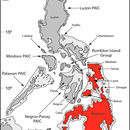pt-BR
nomes no trilho de navegação


According to the IUCN categories and classification structure, we consider the conservation status of this species as “Least Concern (LC),” pending the collection of additional information that might suggest otherwise.
Eutropis multicarinata multicarinata can be distinguished from congeners by the following combination of characters: (1) body size relatively large (59-87 mm SLV for mature adults); (2) 6-7 upper and lower labials; (3) dorsal and later scales with 5-9 keels; (4) 36-42 middorsal scale rows between parietals and base of tail; (5) 28-32 midbody scale rows; (6) ear moderate, usually without lobules; (7) interparietal moderate to large, but relatively narrow; (8) parietals usually separate; (9) 22-28 lamellae beneath 4th toe; (10) 7-9 lamellae beneath 1st toe (Brown & Alcala, 1980).
Color in preservative: Dorsum tannish olive green to brown, usually with a narrow, dark brown to blackish vertebral stripe from nape to region of fore limbs and often a series of dark brown to blackish spots along the dorsolateral margin at least anteriorly; upper lateral surface dark brown to blackish, frequently with a narrow, light line along the dorsal edge anteriorly; a somewhat wider light solid or broken stripe from labials through ear to region of fore limbs; venter bluish or grayish flesh to light slate, frequently with numerous or scattered small black spots on chin and throat (Brown & Alcala, 1980).
Eutropis multicarinata multicarinata is distributed throughout the southern islands of the Philippine Archipelago including Basilan, Mindanao, Dinagat, Leyte, Samar, Bohol, Camiguin, Mantique, and Sulu Islands.
Mindanao Pleistocene Aggregate Island Complex (PAIC; Brown and Diesmos, 2002).
Eutropis multicarinata multicarinata can be found active on the forest floor and low on tree trunks, as well as beneath rotting leaves, under the bark or in the debris of rotting logs in original forest and secondary growth from sea level to about 1000 meters.
Eutropis multicarinata multicarinta can be distinguished from the other subspecies of Eutropis multicarinata (borealis) by the following: (1) interparietal relatively long, narrow to moderate in breadth, separating the parietals; usually a dark, narrow, vertebral stripe; frequently small blackish spots and blotches under the chin and head. E. m. multicarinata occurs on the southern islands of the Philippine Archipelago including the Sulus, Mindanao, Leyte, Samar, Bohol, Dinagat, and Camiguin Island, whereas E. m. borealis occurs on the central and northern islands
This species is oviparous.
59.0-86.5 mm SVL
Philippines; designated holotype (BMNH 1946.8.15.13